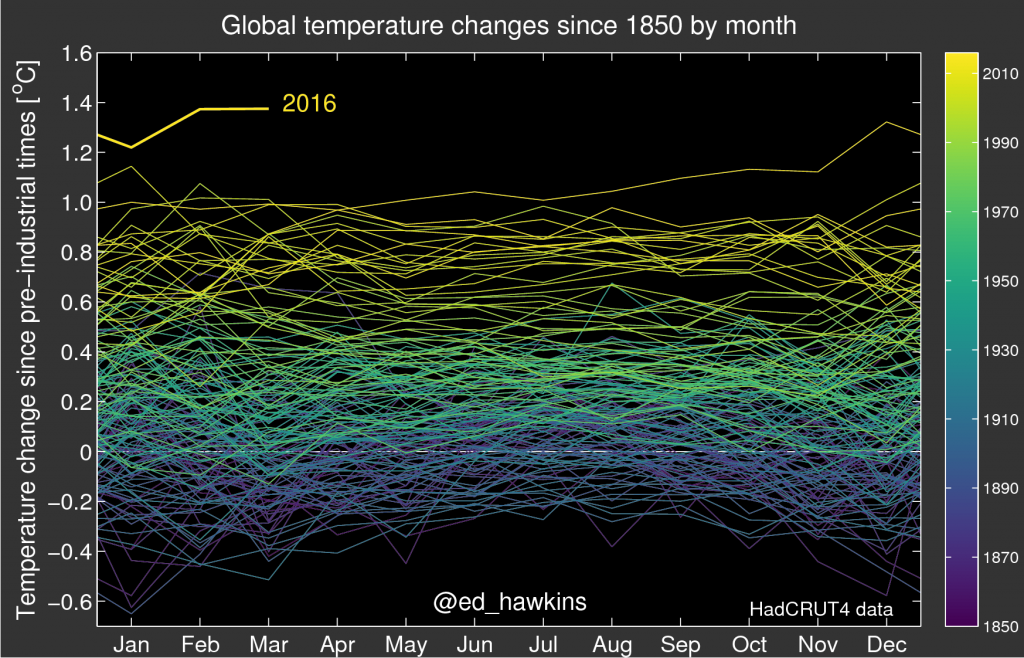All posts by Ed Hawkins
A world before ice
The Earth hasn’t always been struggling with global warming. Around 34 million years ago at the Eocene-Oligocene Transition (EOT) the Earth was undergoing a period of global cooling. This significant shift in climate led to the formation of the first permanent ice sheets of the Cenozoic Era over Antarctica, as shown by the dramatic shift (in a geologic sense) in the oxygen isotope records [1]. The cooling, likely a result of declining atmospheric carbon dioxide levels but potentially also coinciding with Southern Ocean gateway changes, turned Antarctica from a green forested continent to the land of ice we know today. This is illustrated with an image of how this world might have looked.
Guest post by Alan Kennedy, University of Bristol Continue reading A world before ice
Making sense of the early-2000s warming slowdown
It has been claimed that the early-2000s global warming ‘slowdown’ or ‘hiatus’, characterized by a reduced rate of global surface warming, has been overstated, lacks sound scientific basis, or is unsupported by observations. The evidence presented in a new commentary in Nature Climate Change by Fyfe et al. contradicts these claims. Continue reading Making sense of the early-2000s warming slowdown
Expectations for 2016 global temperatures
2015 was hot. Globally, it was the warmest year on record by a large margin. But, there was an El Nino event in the Pacific which probably boosted temperatures slightly (by up to 0.1°C).
So, what can we expect for 2016? Using an analogy of similar El Nino events we can make some suggestions. Continue reading Expectations for 2016 global temperatures
Earth's energy imbalance
Surface temperature rise is often thought of as synonymous with climate change. However a recently published paper in Nature Climate Change argues that Earth’s energy imbalance (EEI) is what ultimately sets the pace of climate change and that substantive progress can be made by monitoring this key climate variable.
Guest post by Matt Palmer and Doug McNeall (UK Met Office) Continue reading Earth's energy imbalance
How to quantify changes in climate extremes without inducing artefacts?
Much evidence has accumulated that temperature extremes and variability are changing. Accurately diagnosing such changes is of vital societal interest, not least because human induced climate change is often expected to materialise primarily through changes in the extreme tails.
Quantifying these features of climate time series statistically in climate models and observations is not straightforward. To a large extent, that is because extreme events are rare by definition, a fact that seems hardly surprising. This fact implies, however, that conventional methods quickly break down when it comes to the tails. This blog post serves s a cautionary note, in which we discuss how apparently very simple methods can result in severely biased estimates, and how this can be avoided1,2.
Guest post by Sebastian Sippel, MPIB, based on Sippel et al. (2015) Continue reading How to quantify changes in climate extremes without inducing artefacts?
2015 in review
2015 has seen some significant climate events, both meteorological and political. Continue reading 2015 in review
Reflections from Paris COP – day 3
What have we learnt at COP21 so far? The 147 world leaders who turned up spoke passionately. The negotiators seem determined to get a strong agreement, already working past midnight each evening. The process of the negotiations seems to be much improved from previous COPs, with small groups doing much of the hard work.
